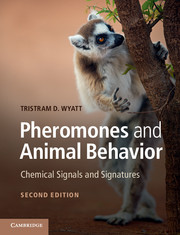Book contents
- Frontmatter
- Dedication
- Contents
- Preface to the second edition
- Acknowledgments
- List of SI prefixes
- List of Abbreviations
- 1 Animals in a chemical world
- 2 Methods for identifying and studying semiochemicals
- 3 Pheromones, chemical cues, and sexual selection
- 4 Coming together and keeping apart: aggregation pheromones and host-marking pheromones
- 5 Territorial behavior and semiochemicals
- 6 Semiochemicals and social organization
- 7 Pheromones and recruitment communication
- 8 Fight or flight: alarm pheromones and cues
- 9 Perception and response to chemical communication: from chemosensory receptors to brains, behavior, and development
- 10 Finding the source: pheromones and orientation behavior
- 11 Breaking the code: illicit signalers and receivers of semiochemicals
- 12 Using semiochemicals: applications of pheromones
- 13 On the scent of human attraction: human pheromones?
- Appendix An introduction to chemical terms for non-chemists
- References
- List of Credits
- Index
13 - On the scent of human attraction: human pheromones?
Published online by Cambridge University Press: 05 June 2014
- Frontmatter
- Dedication
- Contents
- Preface to the second edition
- Acknowledgments
- List of SI prefixes
- List of Abbreviations
- 1 Animals in a chemical world
- 2 Methods for identifying and studying semiochemicals
- 3 Pheromones, chemical cues, and sexual selection
- 4 Coming together and keeping apart: aggregation pheromones and host-marking pheromones
- 5 Territorial behavior and semiochemicals
- 6 Semiochemicals and social organization
- 7 Pheromones and recruitment communication
- 8 Fight or flight: alarm pheromones and cues
- 9 Perception and response to chemical communication: from chemosensory receptors to brains, behavior, and development
- 10 Finding the source: pheromones and orientation behavior
- 11 Breaking the code: illicit signalers and receivers of semiochemicals
- 12 Using semiochemicals: applications of pheromones
- 13 On the scent of human attraction: human pheromones?
- Appendix An introduction to chemical terms for non-chemists
- References
- List of Credits
- Index
Summary
The sense of smell plays a key role in our lives, although we seem to value it the least of our senses, until it is lost. Humans are just one of more than 300 living species of primate, and many primates, from lemurs to monkeys, use chemical communication extensively (Dixson 2012). Chemical information is still important to us, even if we and our nearest relatives, the great apes (the bonobos, chimpanzees, gorillas, and orang-utans), do not appear to use odor communication as much as other primates (Table 13.1) (Dixson 2012; Shepherd 2004; Stevenson 2010). Like other mammals and our fellow primates, humans and the great apes have many sebaceous and apocrine glands giving off a cloud of odor molecules that, with the help of bacterial breakdown, envelop the body with a complex, and individually distinctive, volatile label.
Pheromones might be hidden among the cloud of odor molecules. As we are mammals, it is likely that we do have pheromones (species-wide chemical signals), as most mammals studied so far appear to. However, there is little robust evidence for the existence of human pheromones (though there is early evidence that there might be a pheromone that babies respond to). The claims made on the Internet for irresistible “human pheromones” are baseless: no human pheromones of any kind have been chemically identified yet.
Until relatively recently, smell was thought to be unimportant in humans, largely because of the small relative size of the olfactory bulb in the human brain compared with other mammals. However, the size of olfactory bulbs and the number of neurons they contain may be less important than the extensive central olfactory brain regions in humans, which process the olfactory input (Shepherd 2004, 2012). These dedicated olfactory regions include the olfactory cortex, olfactory tubercle, entorhinal cortex, parts of the amygdala and the hypothalamus, and the medial and lateral orbitofrontal cortex. While relatively speaking we have smaller olfactory bulbs than mice, our olfactory bulb is larger than the entire brain of a mouse and the orbitofrontal region is huge by comparison (Figure 13.1) (Shepherd 2012, p. 112). Even though bulb size is not the critical factor, far from olfaction diminishing in human evolution, an increase in the size of the olfactory bulbs and supporting brain areas appears to have occurred as we diverged from common ancestors with the Neanderthals (Bastir et al. 2011).
- Type
- Chapter
- Information
- Pheromones and Animal BehaviorChemical Signals and Signatures, pp. 275 - 303Publisher: Cambridge University PressPrint publication year: 2014



